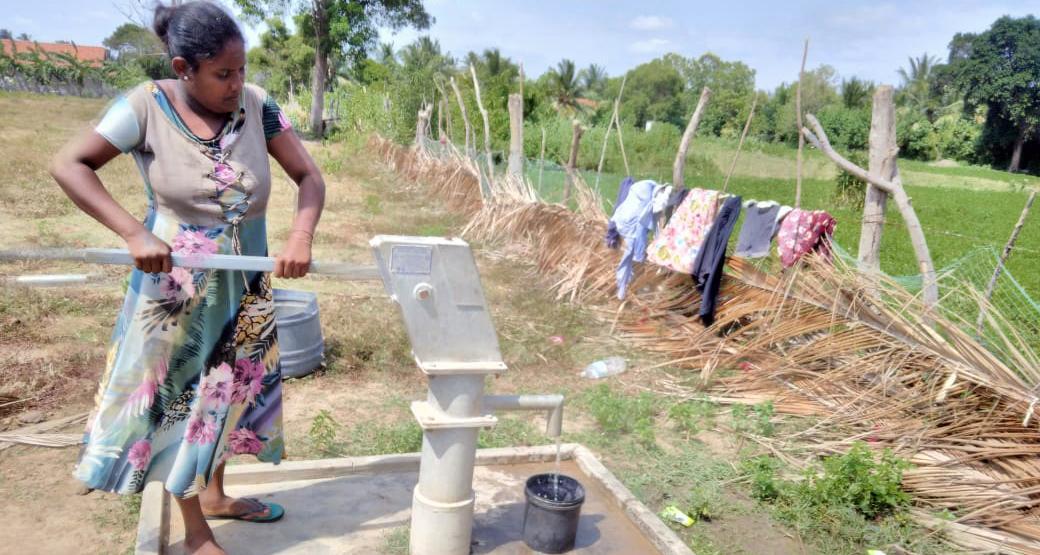
Sri Lanka community overflowing with new life

For 26 years, the sound of sporadic gunfire and explosions had filled the air as a brutal civil war wore on in Sri Lanka. Finally, on May 18, 2009, the conflict ended, marking a new era of peace, reconciliation, and development. But in a small village called Iruttumadu, people were left with scars from the war.
The village was largely destroyed, and healing seemed impossible. Many of the villagers were returning after living displaced by the conflict for years. As they resettled their community, these war survivors faced extreme challenges in nearly every area of their lives.
Iruttumadu is an isolated village in the northern province of Sri Lanka, and the people there receive limited support or assistance from the government or any humanitarian agencies. Dhitri*, a community member, explained that without jobs, they couldn’t rebuild their homes.
They lived in temporary housing for years.
“In the past, before the final stages of the civil war, it was easy to live here. … After the resettlement, we have nothing,” Dhitri said. “If you could come to help us now, we will learn to help ourselves, and you will not need to come and help us again.”
Dhitri’s longing to rebuild is shared by many others in the village. Together with Nazarene Compassionate Ministries Lanka (NCM Lanka), the village launched a five-year project (2017-2022) to assist the community in being independent and self-sufficient. This project aimed to restore hope and transform lives through a holistic and sustainable approach that equipped its members and encouraged cooperation to meet their own needs, providing a safe and uplifting environment for future generations. Now, at the culmination of the project, the transformation is clear.
For many of the villagers, children were—and are—a priority. With the end of the war, children could grow and thrive in a new, trauma-free environment. They could live without fear. Chandra, a long-time community member, has six children and six grandchildren. During the war, his wife became ill and died because they didn’t have access to a hospital. He and the children stayed in Iruttumadu until the last of the conflict was over, but even then, they were forced to try to find a life elsewhere in Sri Lanka.
Away from Iruttumadu, they had to live in a camp for displaced people. Eventually, they returned to the community. Chandra says he hopes that the suffering is over and that his grandchildren will not have the same journey.
“We have gone through enough suffering, but my greatest hope is that our children won’t have to go through the same,” Chandra said
A child-focused arm of the project opened in the village school with 88 children. Now, after five years, the education of 207 children ranging from grade school to high school has been significantly improved. All 278 village children live in a safer environment, too. To begin, NCM Lanka helped hire five government-certified teachers from the village and trained them in holistic care, which means caring for every aspect of a child’s life. The child-focused program focuses on spiritual, mental, educational, nutritional, and social care. The teachers incorporated non-traditional teaching strategies, such as teaching through games, with traditional methods. This led to a considerable positive impact on each child’s performance. Also, the program ensured that kids could eat healthy meals. Every afternoon, nutritious lunch was served prior to the start of the program. This helped parents immensely.
Before the new project, many children dropped out of school because of the distance they had to travel. NCM Lanka collaborated with Helping Hands and presented 11 bicycles to students to continue their higher education. Today all 11 students have graduated and have passed down the bicycles to their siblings to continue their schooling.
Besides education, the project also emphasized strengthening and improving the safety of children in the village. Trainings and policies were translated into the local language, making it possible for community members to create child-safe spaces and become well-versed in child protection. Then, they could also train and support parents to make sure they had the tools to protect their children.
This is an excerpt from a story that previously appeared in NCM Magazine. To read the full story, click here.
